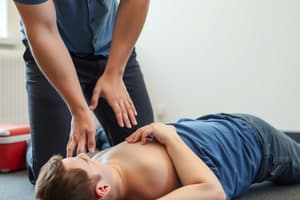Podcast
Questions and Answers
What is an AED?
What is an AED?
- An automatic external defibrillator (correct)
- A type of heart medication
- A pacemaker
- A surgical device
What is the purpose of a shock from an AED?
What is the purpose of a shock from an AED?
To stop the abnormal rhythm and allow the heart's normal rhythm to return.
Match the following public access defibrillation locations:
Match the following public access defibrillation locations:
Airports = Public access defibrillation example Sport facilities = Public access defibrillation example Shopping malls = Public access defibrillation example Healthcare facilities = Public access defibrillation example
How are communities and businesses encouraged to participate in local PAD programs?
How are communities and businesses encouraged to participate in local PAD programs?
Some examples of how to properly maintain an AED include battery replacement and _____.
Some examples of how to properly maintain an AED include battery replacement and _____.
When the AED first arrives, why is it ideal to place it at the victim's side?
When the AED first arrives, why is it ideal to place it at the victim's side?
What is the importance of minimizing the time between the last compression and shock delivery?
What is the importance of minimizing the time between the last compression and shock delivery?
What is an arrhythmia?
What is an arrhythmia?
When do arrhythmias occur?
When do arrhythmias occur?
What are the two types of life-threatening arrhythmias that cause cardiac arrest?
What are the two types of life-threatening arrhythmias that cause cardiac arrest?
What is pulseless ventricular tachycardia (pVT)?
What is pulseless ventricular tachycardia (pVT)?
What is ventricular fibrillation (VF)?
What is ventricular fibrillation (VF)?
What does the AED do when pVT or VF is detected?
What does the AED do when pVT or VF is detected?
What do the following abbreviations stand for?
What do the following abbreviations stand for?
What are the universal steps for operating an AED?
What are the universal steps for operating an AED?
Flashcards are hidden until you start studying
Study Notes
AED Overview
- An automatic external defibrillator (AED) is portable, lightweight, and computerized.
- It detects abnormal heart rhythms, primarily ventricular fibrillation and pulseless ventricular tachycardia, which require an electrical shock.
AED Functionality
- AEDs deliver electrical shocks to restore normal heart rhythm when an abnormal rhythm is detected.
Public Access Defibrillation (PAD)
- PAD aims to have trained personnel and AEDs readily available in public areas where cardiac arrests are likely.
- Common locations for PAD include airports, sport facilities, offices, and healthcare facilities.
Community Involvement in PAD
- Communities are encouraged to register AEDs with local EMS agencies and ensure medical oversight for quality control.
- All expected rescuers should receive training in CPR and AED use.
AED Maintenance
- Regular maintenance includes battery replacement and calibration/testing of energy doses.
- Supplies like AED pads, including pediatric pads, and emergency equipment need timely replacement.
AED Placement
- Positioning the AED next to the rescuer operating it facilitates quick access to controls and pad placement.
- This setup allows another rescuer to perform CPR effectively without obstructing AED use.
Timing of Shock Delivery
- Minimizing the gap between last chest compression and shock delivery significantly increases the chance of restoring a normal heart rhythm.
Understanding Arrhythmias
- An arrhythmia is defined as an irregular or abnormal heartbeat resulting from improper electrical impulse timing.
- Arrhythmias can be too fast, too slow, or erratic.
Life-Threatening Arrhythmias
- The two critical arrhythmias leading to cardiac arrest are pulseless ventricular tachycardia (pVT) and ventricular fibrillation (VF).
Pulseless Ventricular Tachycardia (pVT)
- pVT occurs when the heart's ventricles contract excessively fast, leading to a lack of detectable pulse and oxygen supply to vital organs.
Ventricular Fibrillation (VF)
- VF is characterized by disordered electrical activity, causing the heart muscle to quiver without effective blood pumping.
AED Response to pVT and VF
- Upon detecting pVT or VF, the AED prompts for an electrical shock, which temporarily stuns the heart muscle.
- This shock can stop the arrhythmia and reset the heart's electrical activity, allowing normal rhythm to resume.
- If circulation returns, it's referred to as return of spontaneous circulation (ROSC).
Important Abbreviations
- ROSC: Return Of Spontaneous Circulation
- pVT: Pulseless Ventricular Tachycardia
- VF: Ventricular Fibrillation
- AED: Automatic External Defibrillator
Operating an AED
- Universal steps for AED operation include opening the carrying case and powering on the device as needed.
Studying That Suits You
Use AI to generate personalized quizzes and flashcards to suit your learning preferences.




